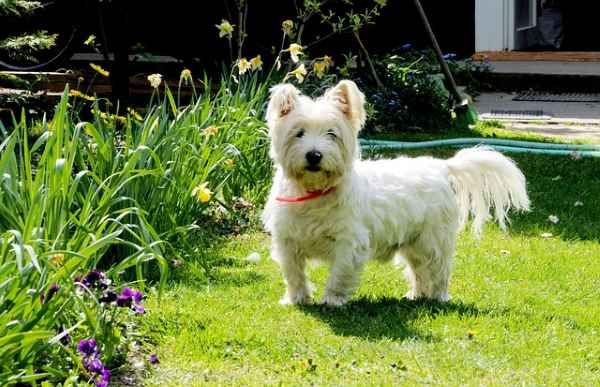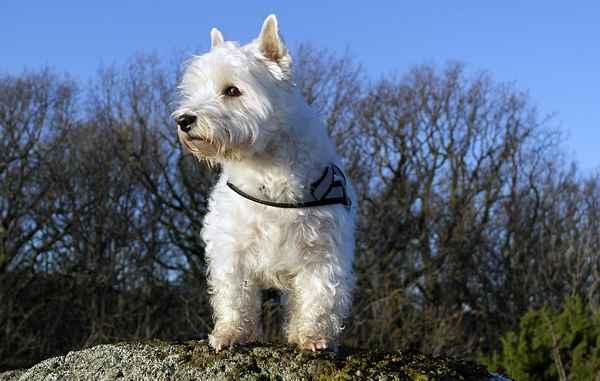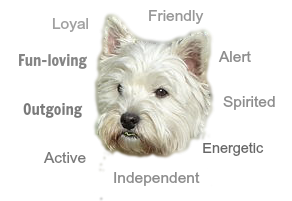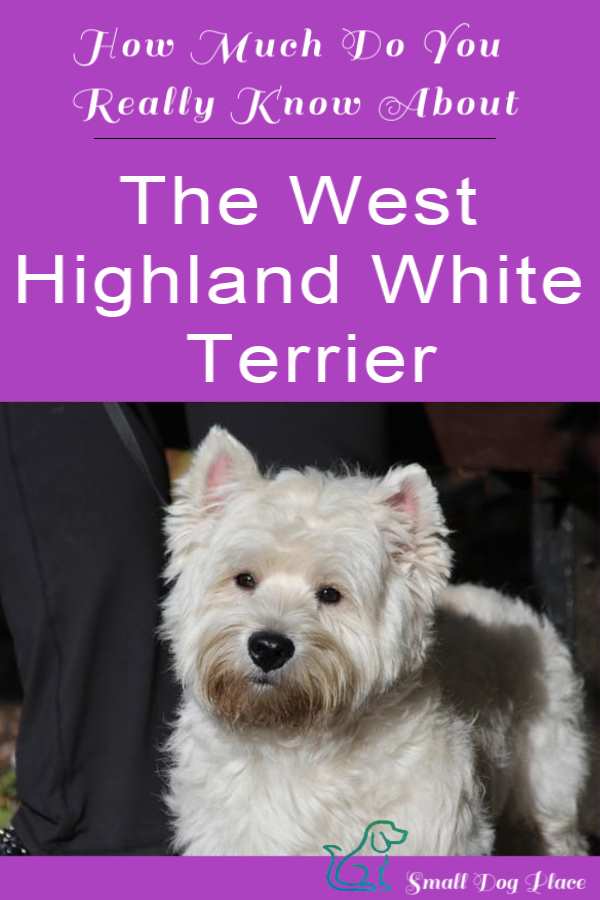West Highland White Terrier (Complete Breed Profile and Info)
By Janice Jones |Last Updated 07-22-2021
You might know the West Highland white terrier from his famous picture on the Caesar food can, or the adorable dog owned by Kahn, Hank’s neighbor depicted on the old TV series King of the Hill.
Without a doubt, there is much more to endear you to this breed than their cute face. Described as an alert, active, independent, friendly breed, these little dogs are true to their terrier heritage.

Quick Facts about the West Highland White Terrier
Other Names Used:
Westie or Westy
Affiliation: AKC, CKC, UK:
Terrier
Size
Height: 10 to 11 inches
Weight: 15 to 22 pounds
Coat Type: Double Coat:
The
outer coat is hard and straight, and the inner coat is soft; Curliness or silkiness
is considered faults in the breed standard.
Colors: White
Country of Origin: Scotland
Activity Level: Active
Life Expectancy: 12 to 16 years
Good with Children: With supervision and gentle handling
Good
with other pets: Not good with small
pets such as hamsters
Dog Breed Ratings Got You a Little Confused?
Here’s a little help in understanding them
- Playfulness: Most Playful = 5 Least Playful = 1
- Affection: Most Affectionate = 5 Least Affectionate = 1
- Friendliness Towards Strangers: Most Friendly = 5 Least = 1
- Good With Children: Great= 5 Not Good with Children = 1
- Good With Dogs: Great = 5 Not Good Around Dogs = 1
- Good With First Time Owners: Fine=5 Not Appropriate = 1
- Exercise Required: Extensive Daily Exercise = 1 Minimal = 1
- Ease of Training: Very Easy = 5 Difficult = 1
- Watch Dog: Excellent Watch Dog = 5 Minimal = 1
- Grooming: Time Consuming = 5 Minimal = 1
- Shedding: Heavy Shedder = 5 Minimal = 1
- Cold Tolerance: Well Tolerated = 5 Poor Tolerance = 1
- Heat Tolerance: Well Tolerated = 5 Poor Tolerance = 1
They are quick to win your heart with their energetic persona and their bright
white coat that just accents their button eyes, making them an initial hit
among anyone who loves a people oriented canine.
I remembered the first time I encountered a Westie many
years ago. It was a time when I was
serving as a vet tech to a local veterinarian.
Working for a very small practice, I got to know all the dogs that
walked through the doors.
But the Westie
I met so many years ago, never walked through the door, rather, he bound
through dragging his unsuspecting new owner behind.
Trying to dodge any obstacle in his path, he
made his way to the reception desk where I stood and literally tried to scale
all 3 feet of it to get to me. I
immediately thought, Wow, there’s some energy, waiting to be harnessed!
Of course, I was thrilled and surprised
because most dogs drag their owners in the opposite direction when they
encounter a vet clinic.
What I later learned was that the West
Highland white terrier makes a great hunter, though few people use them to hunt
these days.
Rather, people love them
because well; they are just plain FUN.
These dogs are self-confident and somewhat independent making them an
ideal choice for someone who doesn’t want a really “needy” dog, but they are
loyal and build close bonds with their favorite humans.
As terriers go, they are highly social, happy
and friendly.
If you think you’d like to participate
in a dog sport, the West Highland White Terrier may be just right.
They do well in earthdog trials, agility, obedience and flyball.
History of the West Highland White Terrier

All of the shorter legged terriers of Scotland including
the Scottish, Skye, Carin, Dandie Dinmont and West Highland white terrier were
bred to hunt small game.
As the story
goes, one day one of Colonel Edward Donald Malcolm of Poltalloch, Argyllshire,
Scotland’s red dogs was mistaken for a fox and killed.
After that, Malcolm decided to breed only
white dogs so they could be seen and recognized during a hunt. These dogs were
called “Poltalloch
Terriers”.
Later, Malcolm did not
want to be known as the father of the breed and asked that the dogs be renamed.
The first breed club was set up in 1904 and
first recognized by the Kennel Club in 1907.
During the same time, the breed, then known as the Rosenearth Terrier
was imported into the United States and recognized by the AKC in 1908.
It was renamed the next year to the West
Highland white terrier. Over the 20th
century, they gained in popularity.
Personality and Temperament of Westies

Vigilant, Friendly, Spirited, Robust,
Active, Independent—these are all words used to describe the Westie’s
personality.
While not considered to be hyper,
they are energetic and will need plenty of exercises which suggest that they
might not be suitable for couch potatoes.
West Highland White Terriers do love to roam and a walk or two each day will help keep meet
their curiosity requirements.
Basically,
they want to be doing what you are doing, so they work very well for active
single, couple or family.
This breed is much easier to housebreak
than other small breed dogs, and they do well with training especially if you
use positive reinforcement and rewards.
Some do very well in obedience trials as they primarily
want to please. There is that “what’s in
it for me,” streak that is found so often in small breed dogs, so patience is
the name of the game.
They do have some
inbred traits that may be difficult to overcome such as digging and chasing
(especially little squirrels and chipmunks), so a fenced in yard is a good
idea.
Remember, the West
Highland White was originally bred to hunt and kill game and vermin in the
rugged Scottish Highlands.
No fence? No Problem, just keep your Westie safely
on a leash when outdoors.
The breed as a whole usually gets along
well with other dogs and household pets, but as you might expect, two unaltered
males may not become best friends, especially if an altered female is
nearby.
Spaying and neutering the dog
will take care of any issues in this regard.
Any household pets that might be perceived as prey for the Westie (i.e.
hamsters, birds, small guinea pigs) will not survive in the same home as a
Westie.
The West Highland White Terrier was traditionally bred for
catching vermin so it’s not surprising that they have a high “prey, drive,”as a result.
Breeds with high prey drives enjoy tossing
and retrieving games, but the object of the game should be a ball or a Frisbee,
not a live animal.
They are not a “yappy” dog, but they
will announce visitors with a bark or two, so they do make good watch
dogs.
They are smart, curious and will
become bored easily if not given enough stimulation.
If you’re looking for a lap dog, this may not
be the breed for you. Some West Highland White Terriers have
been known to be excellent lap dogs, but the vast majority are just to
independent, inquisitive and active to spend their day warming your lap.
Health Concerns of the West Highland White Terrier
Like all dogs, Westies are prone to
certain problems many of which are genetic in nature. Although the list seems long, it doesn’t mean
that one dog will ever suffer from any of them.
Atopic dermatitis (an inherited skin
allergy)
Luxating patellae (knee caps that pop
out of normal position),
Legg-Calvé-Perthes Disease is a condition
involving the hip joints.
Dry eye is a condition of the eye where there is inadequate tear production. Artificial tears may be necessary.
Addison’s disease: This is a rare disease which is also known as Hypoadrenocorticism. It is characterized by a deficient production of
glucocorticoids that lead to symptoms such as weakness, low blood pressure, blood in feces, weight loss and dehydration.
White shaker dog syndrome (or idiopathic steroid responsive shaker syndrome) is a condition that occurs in small white dogs including the Westie and results in body tremors that can lead to seizures and difficulty walking.
Pulmonary fibrosis occurs when scar tissue replace normal lung tissue making it eventually difficult to breath.
Juvenile cataracts: Cataracts are changes that occur in the eye that lead to opacity of the lens. They normally occur in senior dogs, but some breeds including this one may develop them as early as six months of age.
Craniomandibular osteopathy is a
disease that causes jaw deformities in puppies usually under one year old; it
is also known as lion jaw or Westie jaw.
It is an autosomal recessive disease, meaning that both mother and
father must be a carrier to pass on the defect to their offspring.
The bones around the jaw thicken causing
problems for the dog to chew and swallow their food. Treatment involves administering anti-inflammatory
medicine and offering a soft food diet.
Some animals live with the disease throughout their lives but if the dog
cannot eat and seems to be in pain, euthanasia may be the only option.
Grooming the Westie

At first glance, you might decide that a white dog is out of
the question because they would need much grooming to keep their coat glowingly
white. Not so.
The West Highland White Terrier has a double coat with an inner coat being soft, and
the outer coat being harsh. Puppies have
one coat—the outer coat and the soft inner coat will not grow in until about a
year old.
Grooming a show Westie is very
involved but for the pet, grooming is less intense. A good brushing with a slicker brush followed
by combing with a greyhound comb takes care of any snarls and keeps hair
smooth.
In addition, their outer coat tends to prevent dirt from remaining on the dog. Even mud can be brushed off after it dries.
Most pet owners prefer to have their dog groomed professionally every 6 to 8 weeks. When done this way, their coat is clipped making the texture of their hair softer than would be the case for a Show dog.
If that Show Dog appearance is what you love, learning to hand strip the coat is a must and usually the best way to learn this is through the breeder or groomer familiar with this technique.
Hand stripping rather than clipping will retain the wiry texture of the coat.
If cost is a factor and grooming your Westie at home is a real alternative. The cost of Professional clippers is about the same as a couple of professional grooming visits and well worth the investment.
Bathing about one per month is usually sufficient as most Westie’s coats tend to repel dirt. Some owners will use corn starch on the coat sprinkling it on, fluffing out the hair and then brushing.
[
This keeps the coat
clean and odor free. Other grooming
tasks that should be performed include brushing the teeth, clipping the nails, or grinding them down, and trimming any hairs from between the foot pads.
Westies do shed, but not as much as you might think. Brushing weekly will help with this.
Caring For Your West Highland White Terrier
Best Owners for This Breed
A Westie is an excellent choice for novice or experienced dog owners. They do well with singles, couples, and families. Their playful and comical nature make them an ideal companion for children, and older retirees love the idea of having a ready source of entertainment.
If these dogs are walked regularly, they can make good apartment dogs, but barking may be a problem so that will need to be taken into consideration.
They do equally well in family homes and rural settings. A fence will help keep your dog safe while playing outdoors.
He does well with other dogs especially if all dogs in the household have been fixed. Normally cats are not a problem if they have grown up together, but chasing the cat can be an issue.
We don’t recommend mixing Westies with small pocket pets due to their ratting and chasing instincts.
Energy and Exercise Requirements
Your Westie will benefit from a once or twice daily walk or a romp in the yard.
Due to their innate nature to chase anything that movies, your West Highland White Terrier should not be trusted of a leash when outdoors.
A securely fenced area is ideal for rigorous play and exercise and will appreciate and enjoy a game of fetch with his favorite human.
If you are included towards doggie sports, this breed does extremely well in obedience, rally and agility and are naturals at earthdog events.
Training a Westie
This breed is highly intelligent may have an adverse effect on training. They are independent and confident, typical characteristics of terrier breeds. They learn quickly, but many have a very short attention span making long training sessions nearly impossible.
Training can be accomplished through patient positive short training sessions. New owners should expect to have a well trained dog as long as they are consistent and stick with the program.
Housebreaking is a bit easier with this breed than with other small breed dogs. Start from day one to establish a house training schedule and reward for good behavior.
Socialization is very important with this breed so don’t neglect this very important early activity. Since barking can be a problem for some Westies, teaching them to curb their impulses will make life much easier for everyone.
Possible Problem Behaviors of Westies
What to Feed the West Highland White Terrier
These dogs do well on a high quality dog food that is either dry, canned, frozen or raw. Kibble can be provided twice a day after the dog turns 6 months of age.
Before then, meals served three times a day are a good rule of thumb. Depending on the size of the dog, they will eat anywhere between 1/2 to 1 1/2 cups per day. Very active dogs may need a little more.
Check out Evaluating dog food by learning to read labels for more information on how to choose a high quality food. Also, see our guidelines on feeding a puppy or feeding an adult dog.
Snacks can be given in moderation. Both vegetables and fruits make healthy treats but don’t over do as you don’t want to end up with an overweight dog.
How Much Does a Westie Cost?
Most dog adoptions cost approximately $250 to $350 in the U.S. for an adult dog. Senior dogs can be adopted for lower costs and puppies may be a bit higher. To purchase a Westie from a reputable breeder, expect to pay around $1000.
Gifts for the Westie Lover

Pros
- Friendly outgoing, fun loving
- Not much shedding
- Not considered a yappy breed
- Grooming the pet Westie is easy
- Popular which makes them easier to find
- Easy to housebreak
- Easy to train
Cons
- Prone to Digging
- Have a strong Prey Drive so not trustworthy of leash
- Independent
- Not a good Lap Dog
Did You Know?
The West Highland
White Terrier is used frequently in advertisement and branding. Have you seen
Westie on the Black & White Whiskey label?
Caesar Dog Food label
Two Westies on the
Juicy Couture’s Company Logo
My Dog Brand dog food
made by the Australian dog food company, Mars, Inc.
Resources and Further Reading
The more you know about the breed you are considering, the better pet parent you will be. We always recommend purchasing a book or two so you will know and understand your breed thoroughly.
Breed Club
The West
Highland White Terrier Club of America
West Highland White Breed Rescue
Pin for Future Reference

Does This Article Deserve Your Thumbs Up?
We always appreciate your support and encouragement. Your thumbs up means so much to us. Please like this article.
If you find this page or any page on Small Dog Place Helpful, or Useful in anyway, I’d love it if you would click the small heart found on the bottom right of each page.
You can also share or bookmark this page — just click on the:

Free Monthly Newsletter
Sign Up for Our Free Newsletter and get our Free Gift to You.
my E-book, The Top 10 Mistakes People Make When Choosing a Dog (and how to avoid them)




